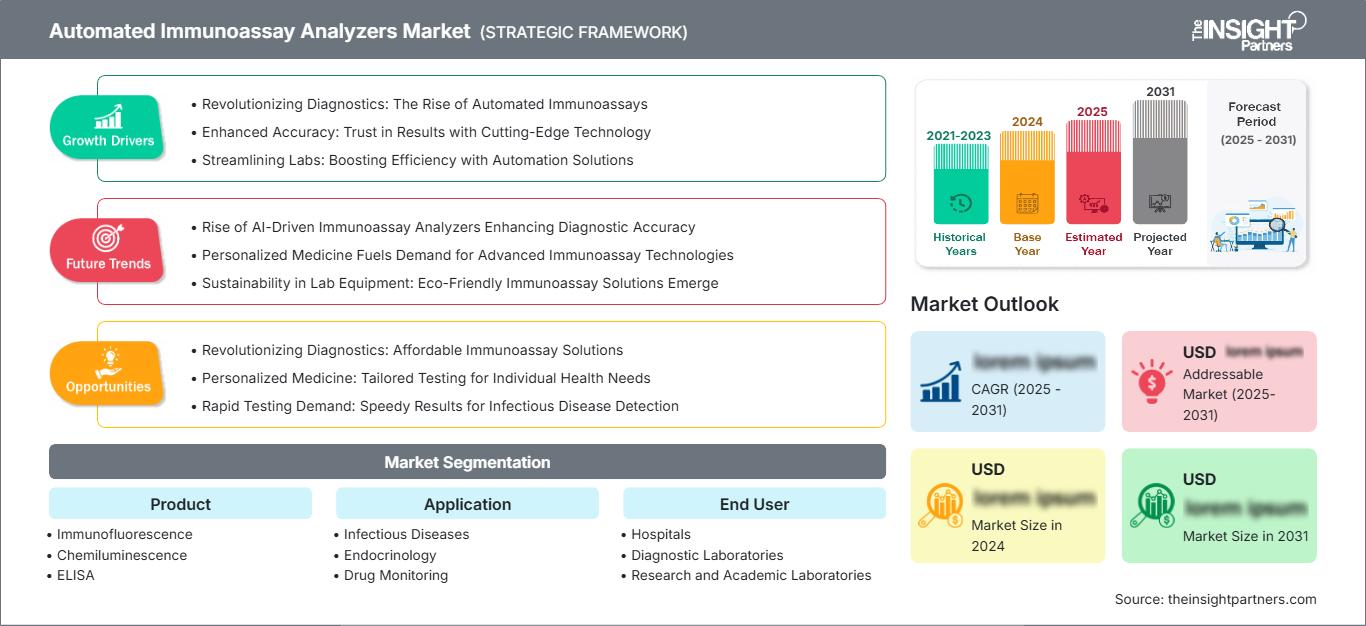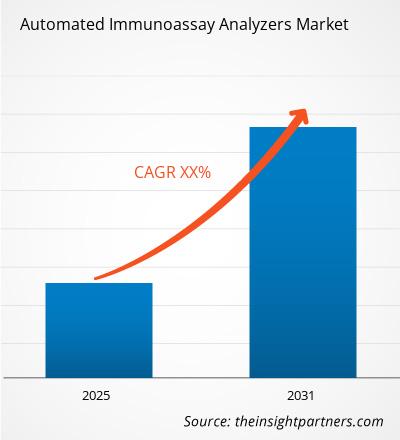Si prevede che il mercato degli analizzatori immunoenzimatici automatici raggiungerà i 65,48 miliardi di dollari entro il 2031. Si prevede che il mercato registrerà un CAGR del 12,5% nel periodo 2025-2031.
Il rapporto è suddiviso per prodotto (immunofluorescenza, chemiluminescenza, ELISA, sistema fluorescente enzimatico, sistema di analisi multiplex, radioimmunoanalisi) e analizza ulteriormente il mercato in base all'applicazione (malattie infettive, endocrinologia, monitoraggio dei farmaci, cardiologia, oncologia, test allergologici). Esamina inoltre il mercato per utente finale (ospedali, laboratori diagnostici, laboratori di ricerca e accademici, aziende farmaceutiche e biotecnologiche). Per ciascuno di questi segmenti chiave viene fornita una ripartizione completa a livello globale, regionale e nazionale. Il rapporto include le dimensioni del mercato e le previsioni per tutti i segmenti, presentando i valori in dollari statunitensi. Fornisce inoltre statistiche chiave sullo stato attuale del mercato dei principali attori, insieme ad approfondimenti sulle tendenze prevalenti e sulle opportunità emergenti.
Scopo del rapporto
Il rapporto "Automated Immunoassay Analyzers Market" di The Insight Partners mira a descrivere il panorama attuale e la crescita futura, i principali fattori trainanti, le sfide e le opportunità. Ciò fornirà spunti a vari stakeholder aziendali, come:
- Fornitori/Produttori di tecnologia: per comprendere le dinamiche di mercato in evoluzione e conoscere le potenziali opportunità di crescita, consentendo loro di prendere decisioni strategiche informate.
- Investitori: per condurre un'analisi completa delle tendenze in merito al tasso di crescita del mercato, alle proiezioni finanziarie di mercato e alle opportunità esistenti lungo la catena del valore.
- Enti di regolamentazione: per regolamentare le politiche e le attività di controllo sul mercato con l'obiettivo di ridurre al minimo gli abusi, preservare la fiducia degli investitori e sostenere l'integrità e la stabilità del mercato.
Segmentazione del mercato degli analizzatori immunoenzimatici automatizzati
- Immunofluorescenza
- Chemiluminescenza
- ELISA
- Sistema fluorescente enzimatico
- Sistema di analisi multiplex
- Radioimmunoanalisi
Applicazione
- Malattie infettive
- Endocrinologia
- Monitoraggio dei farmaci
- Cardiologia
- Oncologia
- Test allergologici
Utente finale
- Ospedali
- Laboratori diagnostici
- Laboratori di ricerca e accademici
- Aziende farmaceutiche e biotecnologiche
Potrai personalizzare gratuitamente qualsiasi rapporto, comprese parti di questo rapporto, o analisi a livello di paese, pacchetto dati Excel, oltre a usufruire di grandi offerte e sconti per start-up e università
Mercato degli analizzatori immunoenzimatici automatizzati: Approfondimenti strategici

-
Ottieni le principali tendenze chiave del mercato di questo rapporto.Questo campione GRATUITO includerà l'analisi dei dati, che vanno dalle tendenze di mercato alle stime e alle previsioni.
Fattori di crescita del mercato degli analizzatori immunoenzimatici automatizzati
- Rivoluzione della diagnostica: l'ascesa degli immunoenzimatici automatizzati
- Maggiore accuratezza: fiducia nei risultati con tecnologia all'avanguardia
- Snellimento dei laboratori: aumento dell'efficienza con soluzioni di automazione
Tendenze future del mercato degli analizzatori immunoenzimatici automatizzati
- Ascesa degli analizzatori immunoenzimatici basati sull'intelligenza artificiale: miglioramento dell'accuratezza diagnostica
- La medicina personalizzata alimenta la domanda di tecnologie immunoenzimatiche avanzate
- Sostenibilità nelle apparecchiature di laboratorio: emergono soluzioni immunoenzimatiche ecocompatibili
Mercato degli analizzatori immunoenzimatici automatizzati Opportunità
- Rivoluzionare la diagnostica: soluzioni di immunoanalisi convenienti
- Medicina personalizzata: test su misura per esigenze di salute individuali
- Richiesta di test rapidi: risultati rapidi per la rilevazione delle malattie infettive
Mercato degli analizzatori immunoenzimatici automatizzati
Le tendenze regionali e i fattori che influenzano il mercato degli analizzatori immunoenzimatici automatizzati durante il periodo di previsione sono stati ampiamente spiegati dagli analisti di The Insight Partners. Questa sezione illustra anche i segmenti di mercato e la geografia della gestione delle malattie del ritmo cardiaco in Nord America, Europa, Asia-Pacifico, Medio Oriente e Africa, America meridionale e centrale.
Ambito del rapporto di mercato sugli analizzatori immunoenzimatici automatizzati
| Attributo del rapporto | Dettagli |
|---|---|
| Dimensioni del mercato in 2024 | US$ XX Billion |
| Dimensioni del mercato per 2031 | US$ 65.48 Billion |
| CAGR globale (2025 - 2031) | 12.5% |
| Dati storici | 2021-2023 |
| Periodo di previsione | 2025-2031 |
| Segmenti coperti |
By Prodotto
|
| Regioni e paesi coperti |
Nord America
|
| Leader di mercato e profili aziendali chiave |
|
Densità degli attori del mercato degli analizzatori immunoenzimatici automatizzati: comprendere il suo impatto sulle dinamiche aziendali
Il mercato degli analizzatori immunoenzimatici automatizzati è in rapida crescita, trainato dalla crescente domanda degli utenti finali, dovuta a fattori quali l'evoluzione delle preferenze dei consumatori, i progressi tecnologici e una maggiore consapevolezza dei benefici del prodotto. Con l'aumento della domanda, le aziende stanno ampliando la propria offerta, innovando per soddisfare le esigenze dei consumatori e sfruttando le tendenze emergenti, alimentando ulteriormente la crescita del mercato.

- Ottieni il Mercato degli analizzatori immunoenzimatici automatizzati Panoramica dei principali attori chiave
Punti di forza
- Copertura completa: il rapporto analizza in modo esaustivo prodotti, servizi, tipologie e utenti finali del mercato degli analizzatori immunoenzimatici automatizzati, fornendo una panoramica olistica.
- Analisi degli esperti: il rapporto è redatto sulla base della conoscenza approfondita di esperti e analisti del settore.
- Informazioni aggiornate: il rapporto garantisce la pertinenza aziendale grazie alla copertura di informazioni e tendenze dei dati recenti.
- Opzioni di personalizzazione: questo rapporto può essere personalizzato per soddisfare le esigenze specifiche del cliente e adattarsi in modo appropriato alle strategie aziendali.
Il rapporto di ricerca sul mercato degli analizzatori immunoenzimatici automatizzati può, pertanto, contribuire a guidare il percorso di decodificazione e comprensione dello scenario del settore e delle prospettive di crescita. Sebbene possano esserci alcune valide preoccupazioni, i vantaggi complessivi di questo rapporto tendono a superare gli svantaggi.
- Analisi storica (2 anni), anno base, previsione (7 anni) con CAGR
- Analisi PEST e SWOT
- Valore/volume delle dimensioni del mercato - Globale, Regionale, Nazionale
- Industria e panorama competitivo
- Set di dati Excel
Report recenti
Testimonianze
Motivo dell'acquisto
- Processo decisionale informato
- Comprensione delle dinamiche di mercato
- Analisi competitiva
- Analisi dei clienti
- Previsioni di mercato
- Mitigazione del rischio
- Pianificazione strategica
- Giustificazione degli investimenti
- Identificazione dei mercati emergenti
- Miglioramento delle strategie di marketing
- Aumento dell'efficienza operativa
- Allineamento alle tendenze normative






















 Ottieni un campione gratuito per - Mercato degli analizzatori immunoenzimatici automatizzati
Ottieni un campione gratuito per - Mercato degli analizzatori immunoenzimatici automatizzati